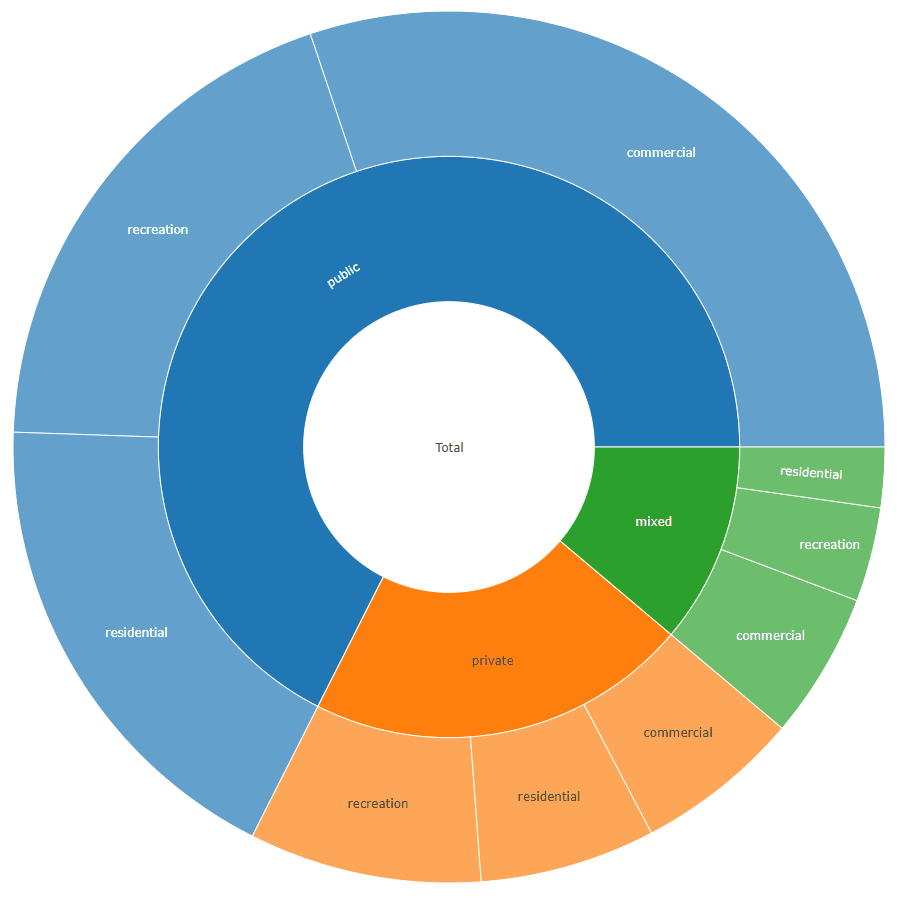You are absolutely right, compared to the rest of the intuitiv usage of plotly's R API preparing data for a sunburst (or treemap) chart is rather annoying.
I had the same problem and wrote a function based on library(data.table) to prepare the data, accepting two different data.frame input formats.
The format required to generate a sunburst plot using data similarly structured as yours can be seen here under the section Sunburst with Repeated Labels.
For your example it should look like this:
labels values parents ids
1: total 1658 <NA> total
2: private 353 total total - private
3: public 1120 total total - public
4: mixed 185 total total - mixed
5: residential 108 total - private total - private - residential
6: recreation 143 total - private total - private - recreation
7: commercial 102 total - private total - private - commercial
8: residential 300 total - public total - public - residential
9: recreation 320 total - public total - public - recreation
10: commercial 500 total - public total - public - commercial
11: residential 37 total - mixed total - mixed - residential
12: recreation 58 total - mixed total - mixed - recreation
13: commercial 90 total - mixed total - mixed - commercial
Here is the code to get there:
library(data.table)
library(plotly)
DF <- data.table(ownership=c(rep("private", 3), rep("public",3),rep("mixed", 3)),
landuse=c(rep(c("residential", "recreation", "commercial"),3)),
acres=c(108, 143, 102, 300, 320, 500, 37, 58, 90))
as.sunburstDF <- function(DF, value_column = NULL, add_root = FALSE){
require(data.table)
colNamesDF <- names(DF)
if(is.data.table(DF)){
DT <- copy(DF)
} else {
DT <- data.table(DF, stringsAsFactors = FALSE)
}
if(add_root){
DT[, root := "Total"]
}
colNamesDT <- names(DT)
hierarchy_columns <- setdiff(colNamesDT, value_column)
DT[, (hierarchy_columns) := lapply(.SD, as.factor), .SDcols = hierarchy_columns]
if(is.null(value_column) && add_root){
setcolorder(DT, c("root", colNamesDF))
} else if(!is.null(value_column) && !add_root) {
setnames(DT, value_column, "values", skip_absent=TRUE)
setcolorder(DT, c(setdiff(colNamesDF, value_column), "values"))
} else if(!is.null(value_column) && add_root) {
setnames(DT, value_column, "values", skip_absent=TRUE)
setcolorder(DT, c("root", setdiff(colNamesDF, value_column), "values"))
}
hierarchyList <- list()
for(i in seq_along(hierarchy_columns)){
current_columns <- colNamesDT[1:i]
if(is.null(value_column)){
currentDT <- unique(DT[, ..current_columns][, values := .N, by = current_columns], by = current_columns)
} else {
currentDT <- DT[, lapply(.SD, sum, na.rm = TRUE), by=current_columns, .SDcols = "values"]
}
setnames(currentDT, length(current_columns), "labels")
hierarchyList[[i]] <- currentDT
}
hierarchyDT <- rbindlist(hierarchyList, use.names = TRUE, fill = TRUE)
parent_columns <- setdiff(names(hierarchyDT), c("labels", "values", value_column))
hierarchyDT[, parents := apply(.SD, 1, function(x){fifelse(all(is.na(x)), yes = NA_character_, no = paste(x[!is.na(x)], sep = ":", collapse = " - "))}), .SDcols = parent_columns]
hierarchyDT[, ids := apply(.SD, 1, function(x){paste(x[!is.na(x)], collapse = " - ")}), .SDcols = c("parents", "labels")]
hierarchyDT[, c(parent_columns) := NULL]
return(hierarchyDT)
}
sunburstDF <- as.sunburstDF(DF, value_column = "acres", add_root = TRUE)
plot_ly(data = sunburstDF, ids = ~ids, labels= ~labels, parents = ~parents, values= ~values, type='sunburst', branchvalues = 'total')

Here is an example for the second data.frame format accepted by the function (value_column = NULL, because it is calculated from the data):
DF2 <- data.frame(sample(LETTERS[1:3], 100, replace = TRUE),
sample(LETTERS[4:6], 100, replace = TRUE),
sample(LETTERS[7:9], 100, replace = TRUE),
sample(LETTERS[10:12], 100, replace = TRUE),
sample(LETTERS[13:15], 100, replace = TRUE),
stringsAsFactors = FALSE)
plot_ly(data = as.sunburstDF(DF2, add_root = TRUE), ids = ~ids, labels= ~labels, parents = ~parents, values= ~values, type='sunburst', branchvalues = 'total')
Please also see library(sunburstR) as an alternative.
Edit: Added a benchmark regarding the dplyr based count_to_sunburst() function from library(plotme) (see below), which on my system is around 5 times slower than the data.table version.
Unit: milliseconds
expr min lq mean median uq max neval
plotme 50.4618 53.09425 60.92404 55.37815 63.62315 122.3842 100
ismirsehregal 8.6553 10.28870 12.63881 11.53760 12.26620 108.2025 100
Code to reproduce the benchmark:
# devtools::install_github("yogevherz/plotme")
library(microbenchmark)
library(plotme)
library(dplyr)
library(data.table)
library(plotly)
DF <- data.frame(ownership=c(rep("private", 3), rep("public",3),rep("mixed", 3)),
landuse=c(rep(c("residential", "recreation", "commercial"),3)),
acres=c(108, 143, 102, 300, 320, 500, 37, 58, 90))
as.sunburstDF <- function(DF, value_column = NULL, add_root = FALSE){
require(data.table)
colNamesDF <- names(DF)
if(is.data.table(DF)){
DT <- copy(DF)
} else {
DT <- data.table(DF, stringsAsFactors = FALSE)
}
if(add_root){
DT[, root := "Total"]
}
colNamesDT <- names(DT)
hierarchy_columns <- setdiff(colNamesDT, value_column)
DT[, (hierarchy_columns) := lapply(.SD, as.factor), .SDcols = hierarchy_columns]
if(is.null(value_column) && add_root){
setcolorder(DT, c("root", colNamesDF))
} else if(!is.null(value_column) && !add_root) {
setnames(DT, value_column, "values", skip_absent=TRUE)
setcolorder(DT, c(setdiff(colNamesDF, value_column), "values"))
} else if(!is.null(value_column) && add_root) {
setnames(DT, value_column, "values", skip_absent=TRUE)
setcolorder(DT, c("root", setdiff(colNamesDF, value_column), "values"))
}
hierarchyList <- list()
for(i in seq_along(hierarchy_columns)){
current_columns <- colNamesDT[1:i]
if(is.null(value_column)){
currentDT <- unique(DT[, ..current_columns][, values := .N, by = current_columns], by = current_columns)
} else {
currentDT <- DT[, lapply(.SD, sum, na.rm = TRUE), by=current_columns, .SDcols = "values"]
}
setnames(currentDT, length(current_columns), "labels")
hierarchyList[[i]] <- currentDT
}
hierarchyDT <- rbindlist(hierarchyList, use.names = TRUE, fill = TRUE)
parent_columns <- setdiff(names(hierarchyDT), c("labels", "values", value_column))
hierarchyDT[, parents := apply(.SD, 1, function(x){fifelse(all(is.na(x)), yes = NA_character_, no = paste(x[!is.na(x)], sep = ":", collapse = " - "))}), .SDcols = parent_columns]
hierarchyDT[, ids := apply(.SD, 1, function(x){paste(x[!is.na(x)], collapse = " - ")}), .SDcols = c("parents", "labels")]
hierarchyDT[, c(parent_columns) := NULL]
return(hierarchyDT)
}
microbenchmark(plotme = {
DF %>%
rename(n = acres) %>%
count_to_sunburst()
}, ismirsehregal = {
plot_ly(data = as.sunburstDF(DF, value_column = "acres", add_root = TRUE), ids = ~ids, labels= ~labels, parents = ~parents, values= ~values, type='sunburst', branchvalues = 'total')
})
